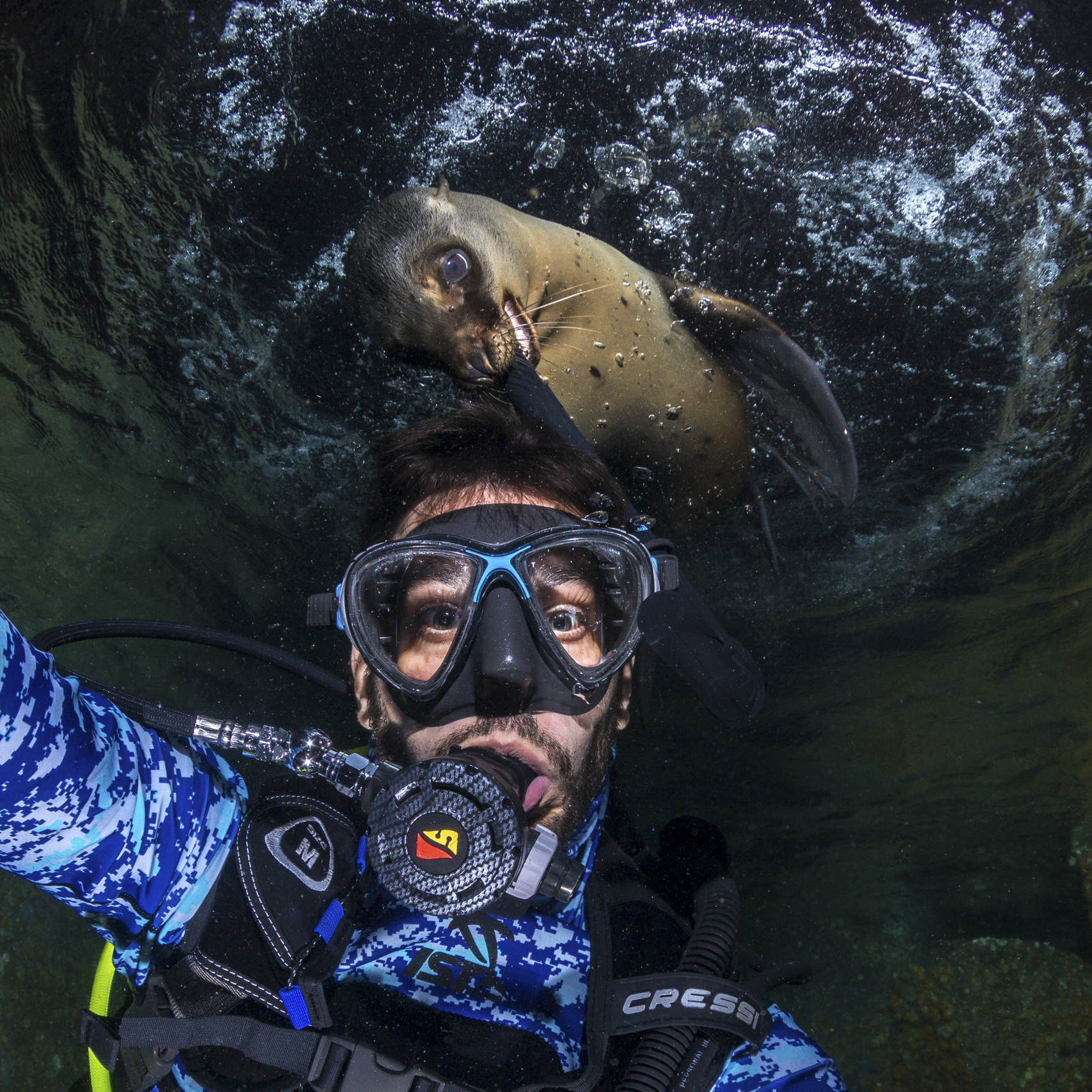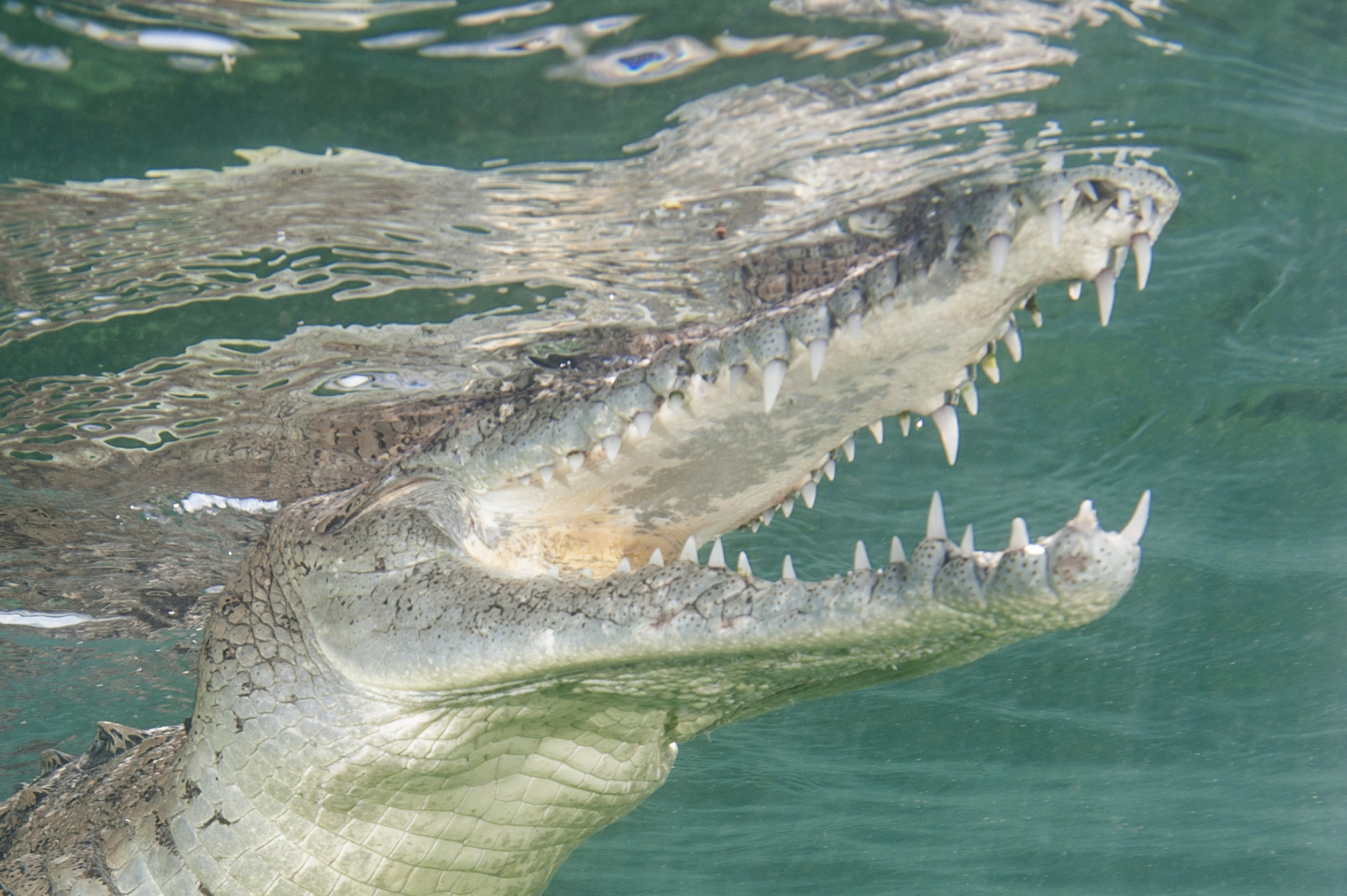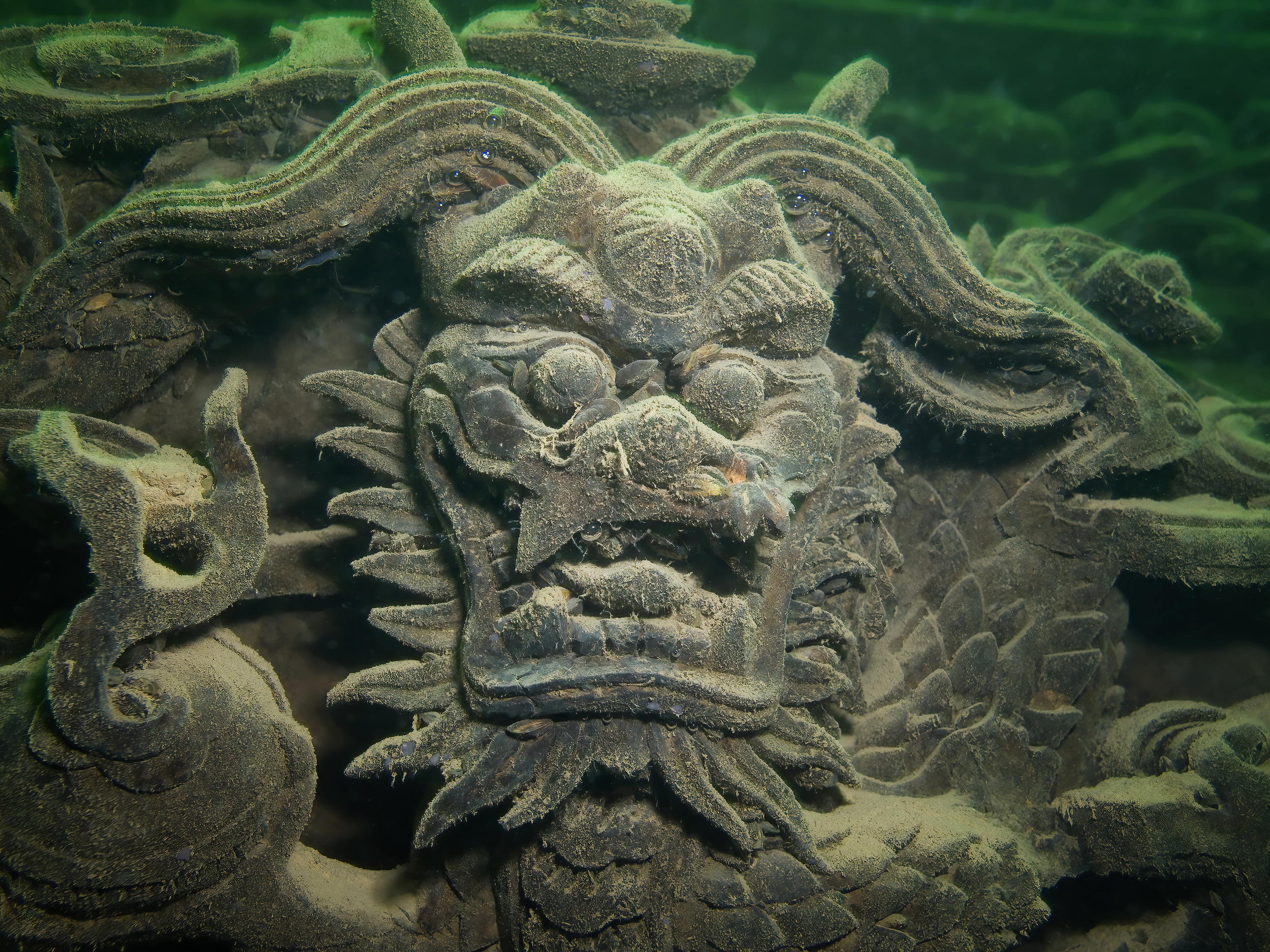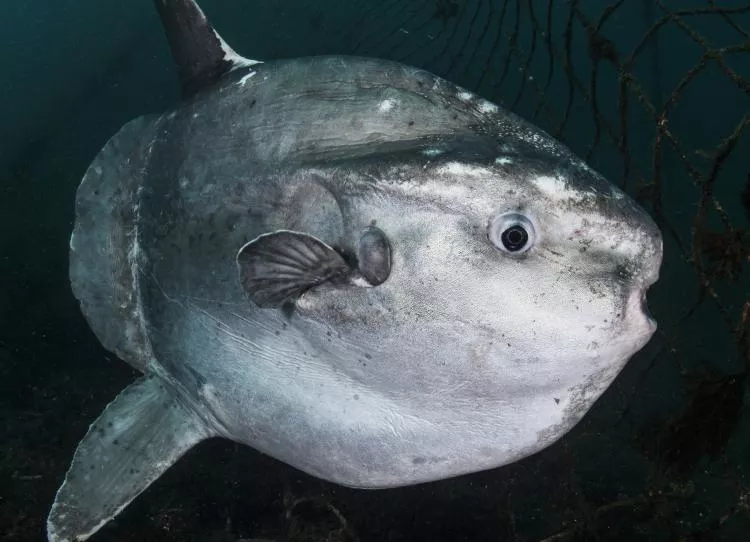We asked our contributors what their most unusual or unexpected dive was and they sent us photos and tales of unique experiences under the waves, some involving interactions with intriguing species, others purely chance encounters or surprising discoveries. From the tropical waters of Indonesia, the Philippines, Marshall Islands, Mexico's Revillagigedo Islands, Kona in Hawaii and Cuba, to the subtropical waters off the eastern coast of Florida in the United States and Mexico's Los Islotes, to the temperate waters of South Africa, Japan and the Puget Sound in America's Pacific Northwest, to a freshwater lake in China, X-Ray Mag contributors share their favorite uncommon underwater moments.
Contributed by
(To see all the photos, please scroll down and download the full article PDF.)
Net Traps, Chiba, Japan
Text and photos by Martin Voeller
Japan is a country known for its fishing industry, and it should be no surprise that the Japanese coasts are controlled by the country’s fishers. There are pockets of areas along the coast where the fishers will have their stationary net traps set up in shallow waters—called teichi-ami in Japanese—and many fish that get caught in these nets are then sold off to the fish markets.
Mackerel, sardines and herring are some of the most common fish found in these nets, but oftentimes, larger fish that prey on these fish can end up in these nets as well—these can include sharks and sometimes even whales. A dive shop located in Chiba, Japan, will often rescue these larger fish, but they cannot simply be released back to the ocean, as they are most likely weak and injured from getting caught inside the net.
The dive shop has created a colossal, rectangular net-enclosure, which has been placed in the open ocean, and this is where some of these larger, frequent visitors (including mola molas and whale sharks) are temporarily housed and fed. This allows the fish to heal from their injuries and, in the interim, divers can dive inside this enclosure before the fish are released back into the wild.
This dive, to me, is special—it gives me close encounters with these rare species of fish, with the knowledge that they will soon be released back into the wild after their recovery. Please visit: poseidonphotos.com

Miller’s Point, Cape Town, South Africa
Text and photos by Scott Bennett
Situated in False Bay, south of Cape Town, Miller’s Point was my first-ever dive in a kelp forest. As a long-time tropical diver, it was an environment unlike anything I had encountered before. From the seabed at 12m, stands of kelp soared to the surface as urchins, anemones and starfish shrouded the seabed below. Light filtering from above created an ethereal feel, it was like being in an undersea cathedral. I was awestruck!
A highlight was the appearance of broadnose sevengill cow sharks, usually a deep-water species, but commonly observed here. Patrolling the channels between the kelp, they are an ancient species measuring up to 3m in length. They are also inquisitive, closely approaching divers before veering off at the last second. One came so close, I had to gently nudge it away with my strobe!
On a second visit a few years later, the cow sharks had been scared off by visiting orca, but there was no shortage of fish action. As soon as our dive guide Ernest opened his bag of fishy treats, we were literally engulfed by a fish frenzy. Vivid red romans were especially bold, joined by other species, including hottentots and red steenbras. Octopus can also be seen, but their immaculate camouflage requires closer scrutiny of the seabed.
There were also plenty of smaller sharks. Small, but brimming with attitude, the aptly named pyjama sharks zoomed past, looking for morsels, while leopard catsharks and puffadder shysharks were much more placid. The surrounding area was familiar to many of my fellow divers, having been featured in popular documentaries such as Blue Planet II and My Octopus Teacher. Visit: xray-mag.com/Contributors/Scott-Bennett

Tourist Submarine, Kona, Hawaii
Text and photos by Larry Cohen
I had one of my most unusual dives when in Kona, Hawaii, while exploring the wreck of the Predator with Jack’s Diving Locker. I was photographing my dive buddy, Olga Torrey, when I discovered one of my fiber optic cables was not working. I decided to keep shooting. I had to reposition my strobe, and I concentrated on the details of the wreck and small marine life, so I could light the subjects with one strobe.
As I was shooting, we heard a rumble in the distance. The thunder got louder and louder, then we spotted a strange shadow in the distance. As it got closer, we were surprised by a submarine! The Atlantis tourist submarine also wanted to explore this shipwreck. Through the portholes, we spotted the smiling faces of children and their parents. They were very excited to see a group of scuba divers swimming around the wreck. Of course, I was excited to document a submarine cruising around the wreck and the tourists’ excitement inside the sub.
I thought this was an excellent opportunity, but I only had one working strobe! So, I mainly used ambient light to photograph the large submarine and used my one strobe to fill in the shadows. The strobe still helped bring out the details to show the inhabitants of the sub.
I used an Olympus OM-D E-M1 in an Aquatica housing with the Olympus 9-18mm lens to capture the images. One Sea&Sea YS-D1 strobe was used for lighting. The ISO was set at 200, and the aperture at f/11. The shutter speed varied from 1/100 to 1/320. Please visit: liquidimagesuw.com

Komodo, Indonesia
Text and photos by Lureen Ferretti
Selecting the most extraordinary dive is impossible. Every dive I have had brings back fond memories and has offered something unique and special—from sharks, mantas and brilliant, colorful, healthy soft corals to pygmy seahorses and ornate ghost pipefish, the experiences have been endless.
This task brought back so many fantastic memories, causing me to change my mind several times before finally deciding on Komodo, Indonesia. It won out due to the abundance and variety of both marine and terrestrial life.
The checkout dive was conducted in a relatively shallow site with little to no current but LOADED with critters. The first subject our dive guide pointed out was a thorny seahorse, then a stone’s throw away was not one, not two, but three ornate ghost pipefish! Of all species on this trip, I saw more pipefish than on all prior dive trips combined. However, it was not all about the little critters—there were plenty of mantas and whale sharks as well. For the first time, I saw the playful side of a whale shark. If I had been unfamiliar with whale sharks, this individual’s odd behavior would have frightened me: Whenever a diver exhaled, the whale shark swam directly towards that diver to suck in the bubbles. It was the funniest thing to watch.
The reefs of Komodo were spectacular, and the water clarity was so clear. We saw rays for days. The surface views were just as breathtaking. Every morning, I joined other guests for morning tea as we watched the sun rise.
No trip to Komodo would be complete without seeing the Komodo dragons. I went to Rinca to see them, but they inhabit four other nearby islands as well. Although they generally spend their time sleeping, I managed to catch two of them in a wrestling match while the others lay around completely uninterested.
The last dive in Komodo left me yearning to return. We hit the reef in the late afternoon; there were thousands of fish, of many shapes, sizes and species. The tuna and jacks were hunting, and every time they dived towards their prey, the entire school of fish would change direction. It was the first time I heard the sound of schools of fish changing directions abruptly, and in such a large mass that it was audible. That dive is forever imprinted in my memory. Visit: DeepWaterPics.com

Sea Lion Pups, Los Islotes, Baja California Sur, Mexico
Text and photos by Frankie Grant
During the fall, about an hour’s boat ride from La Paz, Mexico, newborn sea lions finally begin venturing into the warm waters surrounding Los Islotes. The character and behavior of these sea lion pups makes for one of the most spectacular pinniped interactions in all of North America.
On this particular day, it was not necessarily that the sea lion pups were being playful, as this is quite common, but more so the type of interaction and level of engagement of the animals. I enjoyed their presence for over an hour, tucked within a shallow slot in the island with the two pups. They are known to chase bait and carry rocks and sea stars in their mouths, but on this unexpected occasion, one was a bit more boisterous. The pup began trying as best it could to chew on and remove my snorkel and even my mask. The two of them worked together to distract me with acrobatics, while the other would go for the snorkel. What a treat! Visit: frankiegrant.com.

Puget Sound, Washington, USA
Text and photos by Jennifer Idol
Nothing is quite as exhilarating as the feeling of discovery. On my first trip through the Puget Sound, I was heading to Hawaii, an expected destination, but decided to pause for some dives in Seattle. This proved most rewarding, as I discovered for myself the Pacific Northwest and the unusual life in its waters. From wolf eels to giant plumose anemones, I was smitten by the variety of substantive subjects.
This surprise spurred future trips to learn more about this unique habitat. Although cold water is challenging, it has proved the most rewarding for me in terms of subjects. Life is unexpectedly rich in cold waters and of a larger size than expected.
Giant Pacific octopus and wolf eels make the region famous, but even stranger life, such as the tall sea whips and Lewis’ moonsnail, keep alive the search for more life. From kelp rockfish to lingcod, the fish life is also abundant. Puget Sound is easy to shore-dive in its many inlets and is protected from the turbulence of the open sea. For the macro-oriented, large nudibranchs can also be found in the region.
Alki Beach is probably the best known and easiest shore entry I experienced. Puget Sound also connects directly to other areas such as Hood Canal and includes the cities of Seattle, Tacoma, Olympia and Everett.
Although I aim to be prepared for all surprises through research and experience before diving a location, some of the greatest joy can come from a positive revelation. Please visit: uwDesigner.com

New Reef, Gordon's Bay, South Africa
Text and photos by Kate Jonker
It was one of those perfect days. The sea was as flat as a mirror and we decided to dive one of Gordon’s Bay’s farther reefs. As the boat skimmed across the ocean, we noticed a boat was already on the reef we had planned to dive. Not wanting to drop us where there would be folk fishing, the skipper decided to head over to the other reef in the area, which was about a kilometre away. As we approached the other reef, my heart sank with disappointment—there were three fishing boats there, too!
But the skipper had a plan up his sleeve. He knew of an undived reef close by and asked if we wanted to go and take a look. Always ready for an adventure, we all jumped at the chance to dive uncharted territory! We had a diver who mapped reefs on board, and he was also keen to add this to his collection. Before long, we were descending the shot line. The feeling of excitement and anticipation was palpable—what would we see? What would the reef be like?
As we approached the reef, an incredible sight greeted us—huge clouds of snow carpeted the floor, broken only by pinnacles of yellow and pink. The seabed was covered with huge clumps of very unusual white choirboys, and the pinnacles were swathed with yellow and pink multicoloured sea fans and huge colonies of fragile yellow bryozoans. Basket stars swayed on larger sea fans and little puffadder catsharks swam lazily amongst the drifts of snow-like choirboys. A huge variety of nudibranchs lounged on the pinnacles, with bellies full from feasting on their favourite bryozoans and sea fans.
All too soon, we made our way slowly to the surface. Once on board, I asked the skipper and mapper to keep the reef a secret as the delicate marine life could easily be damaged by less careful divers. Unfortunately, the mapper did eventually make the coordinates public, but named the reef “Kate’s Secret Reef,” which was a bit of a contradiction in terms! My motto has always been “expect the unexpected” when diving—and this really was one of those occasions. Visit: katejonker.com

Crocodiles, Garden of the Queen, Cuba
Text and photos by Matthew Meier
The American crocodile is a prehistoric creature that has been on this earth since the days of the dinosaurs and coming face-to-face with them in Cuba was one of the highlights of my diving career. The crocodiles live amongst the mangroves and shallow sea grass beds that make up this marine protected area. Encounters typically occur while on a surface interval between dives, and at times, the water is not deep enough to do anything but snorkel. When in the water, I often found myself looking over the top of my camera housing as a reminder of how close I was to these impressive reptiles. The dive guides control interactions, and only a couple of people are allowed in the water at a time. While the operators have been diving with the crocodiles without incident for many years, the animals have lightning-fast reflexes and can be unpredictable. It is never a good idea to let your guard down in their presence. Visit: MatthewMeierPhoto.com

Mr. Bones, Marshall Islands
Text and photos by Brandi Mueller
The best ideas are formed around 11 p.m. surrounded by dive buddies and maybe a few adult beverages, right? In this case, it was the night of Halloween, and while most divers were in ocean-themed costumes, one friend was carrying around a life-size skeleton named Mr. Bones. The brilliant idea was to take Mr. Bones on a dive to our favorite wreck around Kwajalein Atoll, the Palawan, which has a very photogenic stern steering wheel.
The next morning, I found myself driving a boat to the wreck with three other divers… well, four actually—can’t forget to include Mr. Bones! Not knowing how he would behave underwater, we moored the boat in a shallow, sandy spot and tested his skills. To make him sink, we zip-tied weights to his feet. He gave us the okay sign, and we took him to the wreck.
On the boat ride, we had a slight issue that required emergency spine and rib surgery on Mr. Bones, but a few more zip-ties had him back in one piece. After descending to the Palawan, we placed Mr. Bones at the helm, and as my friends exited the scene, I took a few shots. My friend Tim gave me a signal to stop shooting, as he swam over to Mr. Bones to adjust his gauzy shawl. With it floating perfectly in the current, I snapped my favorite shot of the session, and we managed to get Mr. Bones safety back to shore and put him back into retirement until the next year’s Halloween wreck dive. Visit: brandiunderwater.com

Goliath Grouper, Wreck Trek, Jupiter, Florida, USA
Text and photos by Gary Rose, MD
It was just another wonderful late summer day of diving the Wreck Trek in Jupiter, Florida, when I found myself in the middle of the annual goliath grouper aggregation. I was surrounded by at least one hundred of these colossal animals. Most were between four to six feet long and a few were as long as eight feet. I then spotted a tightly packed group of ten of them heading to a rubble pile. I took a photo and then they mysteriously vanished, in an instant, into the rubble.
Then, right in front of me was a 600-pounder, looking at me with a goliath grouper smile, and beckoning me to follow… if I dared. She led me into an opening, that with camera and tank, I had to squeeze carefully through.
Suddenly, I was in a tunnel packed with at least 50 goliath groupers. I was surrounded, buffeted, and heaved by these giants. There was no room to turn around. They grunted and rumbled in rage with the resulting shock waves battering me inside and out.
With no way back, I had no choice but to continue forward. The passage was narrow and very dark. I felt like I was going to be crushed at any moment. I sensed the tunnel getting slightly brighter. Was this real or was my hyper-adrenalized mind imagining it? Yes! A blue glow ahead. Increasing light. Suddenly, they battered me one last time in this unique tunnel, and then they pushed me out into glorious aquamarine open water. Visit: garyrosephotos.com

China's Qian Dao – Lake of a Thousand Islands
Text and photos by Don Silcock
By far, my most unusual dive would have to be while I was living in Shanghai as part of an 18-month work assignment in China, where I stumbled on the local diving community, which revolves around training and trips outside of China, apart from diving Qian Dao Lake—some five hours southwest.
Qian Dao Lake was created in 1959 as part of a dam project, which displaced some 290,000 people, many of whom were descended from the founders of the main town, Lion City. The town, which was established about 1,800 years ago, now lies 30 to 40m underwater but was found by the main Chinese TV station, CCTV, during a project about lost ancient treasure. Intrigued, I signed up for the next trip and arranged to bring all my drysuit, dive and camera gear back to Shanghai. Then, on one Friday night in September 2008, we were off for a weekend of adventure!
That night, we stayed just outside Qian Dao National Park; early the next morning, we boarded a ferry to take us across the very scenic lake to the nearest town by the submerged Lion City. A local fishing boat was our dive platform for the weekend and, as we chugged out to the dive site, I noticed a large ship about one kilometre away, which seemed a bit strange. After a briefing and warning that the visibility may be quite bad, we entered the water and started our descent.
At 10m, I could tell that this was going to be an interesting dive, as it went dark rapidly. At about 20m, I was no longer able to see my gauges, and shortly afterwards, my descent halted as I landed in what felt like deep and very soft silt. At that point in time, I was a little concerned—I was in zero visibility, my buddies had disappeared during the descent, I was a very long way from any support, and I was wondering how to explain all this to my wife, should I ever see her again.
After a couple of minutes in the pitch black, I aborted the dive and returned safely to the surface. We did another two dives that day—the story of which was told in a full article on Qian Dao Lake in issue #43. I subsequently found out that the large boat in the distance was actually a dredger, which explained the zero visibility on the bottom! Please visit: indopacificimages.com

Waving Manta Ray, Revillagigedo Archipelago, Mexico
Text and photos by Olga Torrey
I was very excited to do a liveaboard trip on the Nautilus Belle Amie to the Revillagigedo Archipelago in Mexico. I am not comfortable on long boat rides, but I knew the 24-hour ride traveling 285 miles across the Pacific Ocean would be worth getting seasick for. I had never observed giant manta rays before, and I was looking forward to the experience. I could not wait to capture images of the manta rays and the other pelagic marine life for which these islands are famous.
The trip did not disappoint. We encountered whitetip, blacktip and silky sharks. We observed schools of jacks and torpedo scad. Mexican hogfish and Clarion angelfish, which are only found in this region, were in abundance. Even with all that marine life to photograph, the giant mantas were the stars of the show.
On almost every dive, we interacted with up to six of these gentle giants at a time. The mantas seemed as curious about us as we were about them. They allowed us to get extremely close, and we could tell that they were highly intelligent creatures. The mantas enjoyed hovering above the open circuit divers and allowing their exhaust bubbles to give them a massage.
The most unusual part of this trip happened after the last dive. Larry Cohen (my dive buddy) and I stayed with our dive guide and four mantas, after everyone else was back on the small skiff. We enjoyed what seemed like a beautiful ballet as these large, graceful animals moved and spun in all directions. One manta appeared to pay special attention to us.
Finally, it was time for us to leave the water reluctantly. We climbed onto the skiff for the last time to head back to the main boat. Before the motor started, one manta came half out of the water and used his large fin to wave goodbye to us. If I did not see it with my own eyes, I would never have believed this story. To this day, I have tears in my eyes thinking about it, and I have to wonder how the manta knew this was our last dive.
I captured all images with the Olympus OM-D E-M5 camera in a Nauticam housing. I used the Panasonic 7-14mm wide-angle lens and Sea&Sea YS-D1 strobes for lighting. Please visit: fitimage.nyc. (SOURCE: diveninjaexpeditions.com)

Bubbling Reefs in the Philippines and Indonesia
Text and photos by Beth Watson
Two dive sites piqued my interest and curiosity with their unique topography, with both featuring volcanic bubbles. The first dive site is located in the Philippines, just south of Chicken Feather Island, where a small volcanic crater lies. The bottom is covered with volcanic stones. Bubbles of sulphuric gas rise up to the surface, creating shimmering apparitions in the water column.
The rocky substrate is very warm to the touch. In fact, fellow divers and I were able to boil an egg there during one of our dives. The rest of the dive site is varied and diverse, with stunning scenery and a plethora of marine life congregating around and living on the coral formations.
The second dive site is located in a volcanic crater, which is tricky to locate. You will need an experienced guide who is knowledgeable of the area to find it. The Hot Rocks dive site is located in the waters around the volcanic Sangeang Island in Indonesia. The volcano is active, providing streams of volcanic gases rising from the substrate, which creates a breathtaking underwater landscape.
It is dramatic, with the deeper area sporting colorful coral formations and sandy slopes, black coral bushes, gorgonian sea fans, pygmy seahorses, octopus, lobster and nudibranchs.
The Chicken Feather Island and Hot Rocks dive sites are unique and perfectly suited for underwater photography. They both offer diving experiences you will never forget. Please visit: bethwatsonimages.com






























